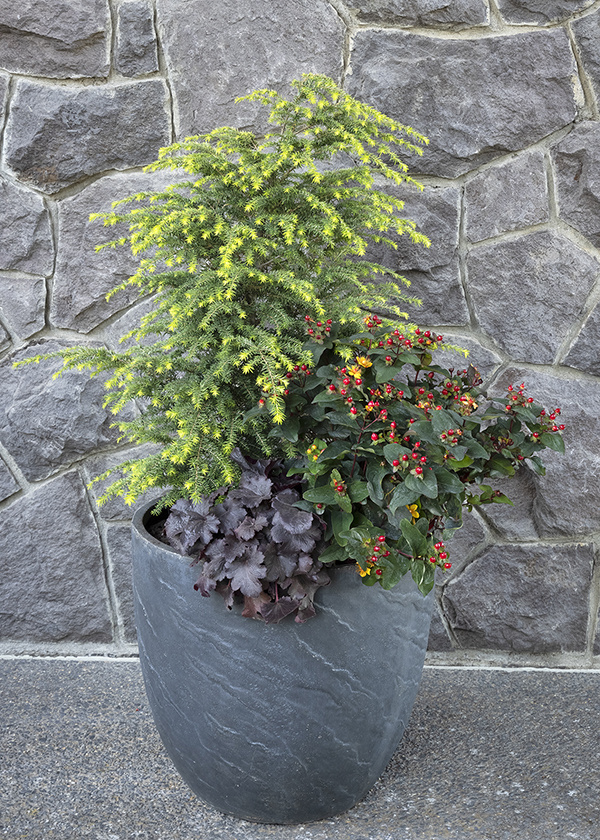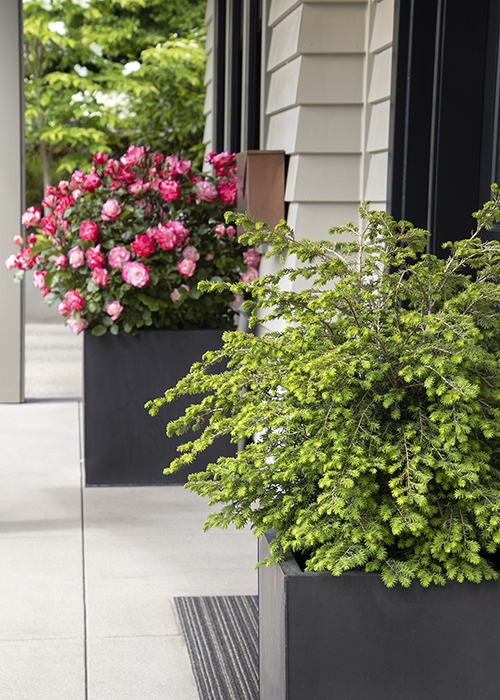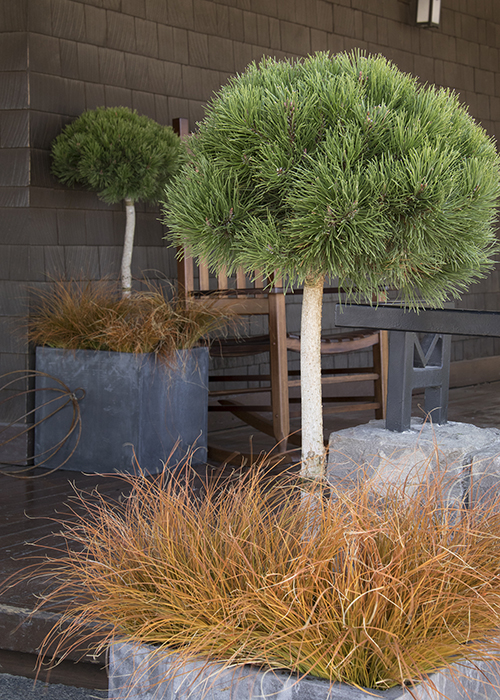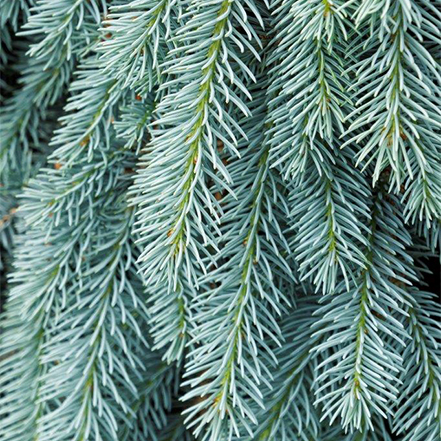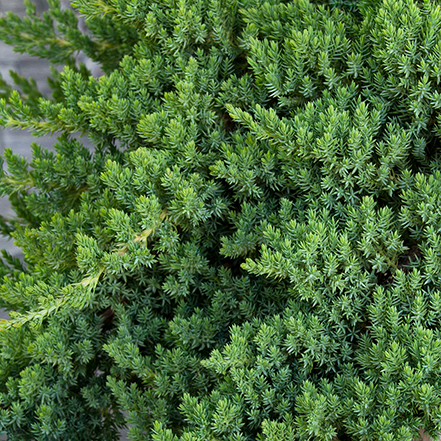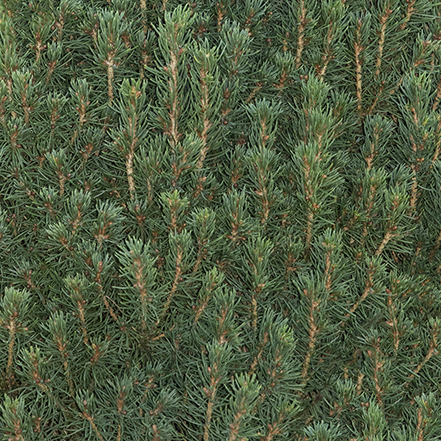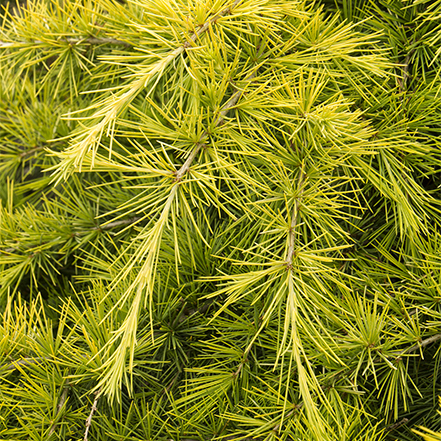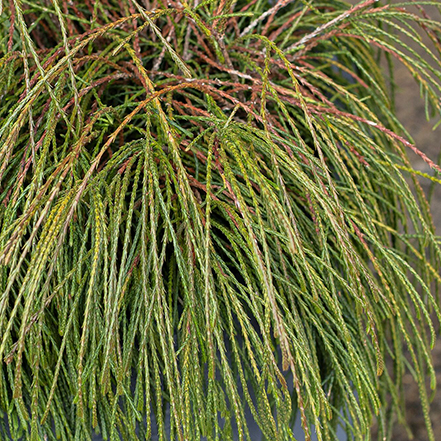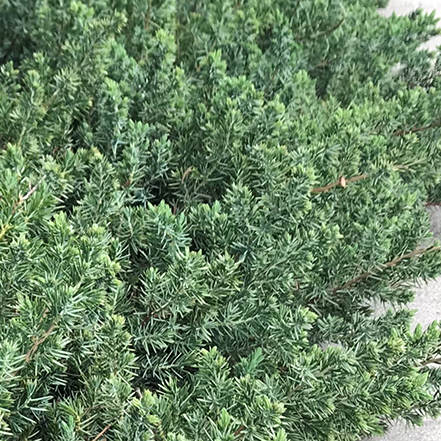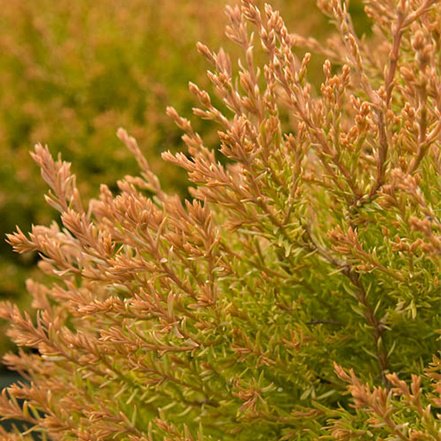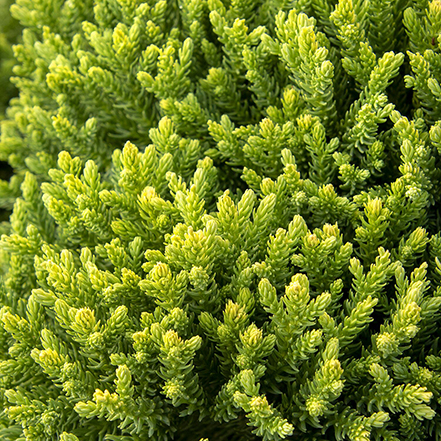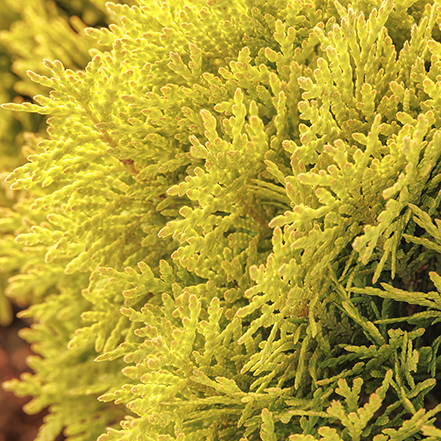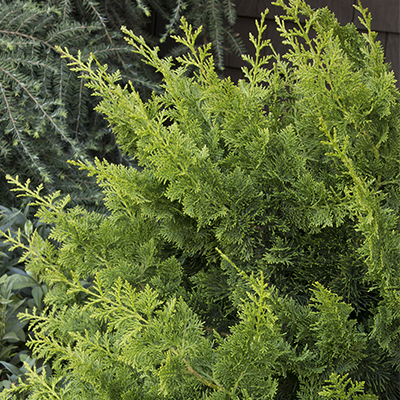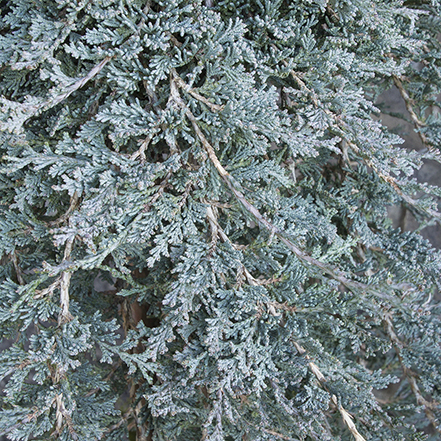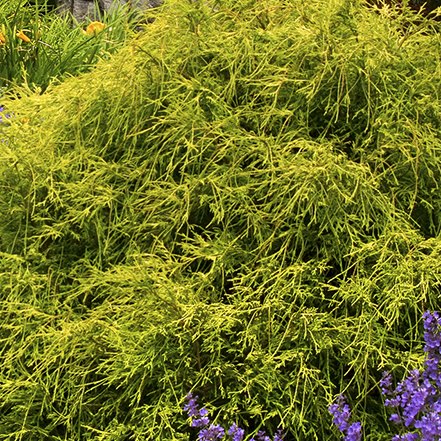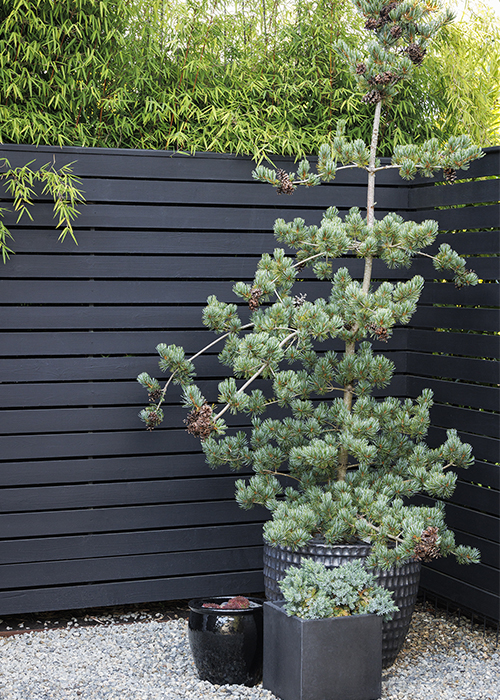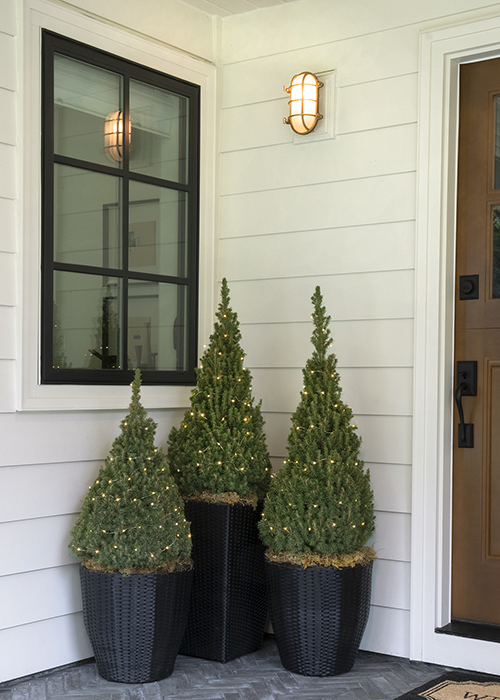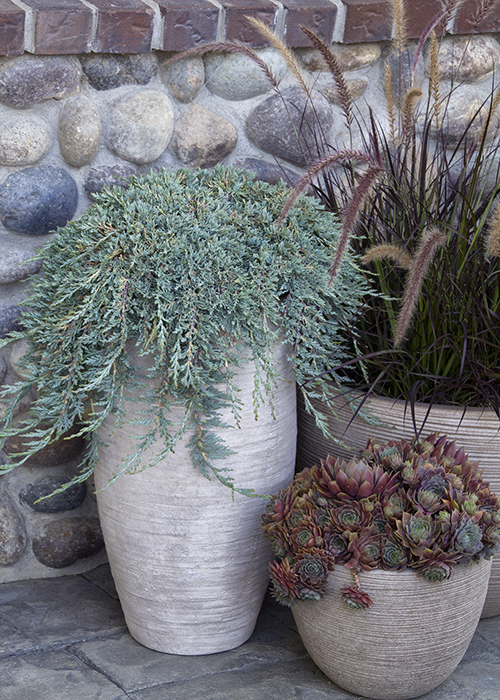Dwarf conifers make ideal container plants and can be an impactful design tool whether adorning porches and patios or placed in the garden. Sometimes container gardens are the only way to bring plant life to an area where planting in the ground isn’t available or suitable. Conifers offer the gardener year-round interest and color in various shapes, sizes, and hues.
(Above) Golden Duke® Eastern Hemlock is combined with FloralBerry® Sangria St. John's Wort and Sirens' Song™ Dark Night to create a container combination that looks fantastic all year long.
Dwarf conifers are slow-growing plants, usually growing only 1-6 inches annually, and with appropriate care, they will thrive for years before outgrowing their pots. And when they do, they can live to grow on in your garden. It is an economical way to start your garden conifer collection.
Ready to get started with your conifer containers? Find design tips, plant recommendations, care tips, and winter care instructions below.
How to Use Conifer Containers to Add Texture
Creative placement of potted conifers can add textural interest and help define garden spaces. The texture of a conifer is experienced visually and refers to the appearance of the foliage. Visual texture can help create a “sense of place” or mood in a garden.
Finely textured plants tend to recede into the background, making a space feel larger. The feathery Emerald Fountain® Canadian Hemlock pictured here, Gold Threadleaf False Cypress, and the attractive Koster’s False Cypress are finely textured conifers that help create a sense of enclosure when containers are placed at the edge of a patio or deck or used to frame an entrance.
Coarsely textured plants are bold and hard to ignore. They’re usually the first plants you notice. The stiff-needled Dwarf Mugo Pine pictured here and Medora Juniper make excellent course-textured container specimens.
Planted singularly in a container or in combination with one another, mixing fine-textured with coarsely-textured conifers adds interest and a sense of movement to any area they are placed.
The Best Conifers for Containers
Sometimes all you need is one sensational exclamation point of a conifer in a pot. It can be upright or cascading in its growth habit or have an artistic sculptural form. Then again, multiple shrubs that create a repetition of from is a fantastic way to improve a garden’s flow. There is a conifer for your design solution. Find the top recommendations below.
Stiking Stand-Alones
Use the strong, sculptural form of conifers like these as focal points and accents, or use them in rows to form privacy walls or windbreaks. Conifers in topiary form are also a fantastic choice as stand-alone or paired accents.
The Blues
Blue Spruce
With no two plants alike, the strongly weeping branches and irregularly spreading and drooping top create a unique, bright silver-blue specimen. It creates a striking and unique focal point in a container. Full sun. Up to 6' tall and wide in natural form. Zones 2-8.
Dwarf Japanese
Garden Juniper
A wonderful evergreen that can be trained into an upright staked specimen, pruned into a variety of interesting topiary forms, and has a superb natural form — no matter the form, it looks fantastic showcased in a container. Bright-green new growth matures to blue-green and tinges purple in winter. Up to 1' tall, 6' wide in natural form; Up to 4' tall in staked form. Zones 4-9.
Tiny Tower® Dwarf
Alberta Spruce
Particularly well-suited for formal topiary, this handsome conifer has an excellent pyramidal form, with a dwarf habit that is perfect for containers. The dense bright green foliage turns an attractive gray-green when mature. Partial to full sun. Up to 6' tall, 2' wide. Zones 3-8.
Let it Flow
These cascading conifers feature branches that trail down vertically. They bring the focus to the ground and offer a soft touch to containers with a waterfall of foliage that flows over the side of the pot.
Feelin' Sunny®
Deodar Cedar
A stunning dwarf cedar selection with bright, golden-yellow foliage that makes an outstanding large container specimen. It begins its life in a low, spreading form. As it ages, it takes on a tall, pyramidal form more typical of the species. Partial to full sun. Up to 15' tall if a leader forms, 8' wide. Zones 7-9.
Whipcord Western
Red Cedar
A dense, multi-stemmed evergreen shrub with finely textured, green foliage and gracefully arching branches that cascade over the sides of containers. Foliage turns bronze in winter, adding further interest to container plantings. Partial to full sun. Up to 5' tall and wide in natural form. Zones 5-7.
Blue Pacific
Shore Juniper
This wonderful, low, spreading form makes a superb cascading container specimen. Dense blue-green foliage gives this selection a handsome appearance and is best when not pruned, but rather left in its natural form. A notably heat-tolerant variety. Full sun. Up to 1' tall, spreading to 7' wide. Zones 5-9.
Unifying Plants
Using repetition of form throughout the garden helps to connect garden spaces and create a cohesive design. A globe-shaped plant is a great choice for this approach — its rounded form is an excellent way to create repetition in the garden, which helps to connect garden spaces.
Fire Chief™ Globe
Arborvitae
This slow-growing, low-maintenance evergreen is perfect for containers. Its nearly perfectly globe-shaped habit has fine, bright-gold spring foliage and fantastic deep-red fall color. This sport of the popular Rheingold has a deeper color and is less prone to splitting. Full sun. Up to 2' tall, 4' wide. Zones 5-8.
Dwarf Japanese
Cedar
A superb selection for containers that retains a natural, dense, dome shape with little care. The finely textured foliage breaks up the bold effects of large-leaved plants. Foliage becomes rusty red in winter. Partial to full sun. Up to 3' tall and slightly wider. Zones 5-7.
Golden Child™
Arborvitae
A compact, rounded evergreen shrub with yellow and yellow-green summer foliage that has shown superior resistance to scorching. The foliage develops a light bronze cast in winter. The slow-growing sport of 'Danica' is a wonderful, low-maintenance option for containers, needing no pruning to maintain its shape. Partial to full sun. Up to 1' tall and wide. Zones 4-8.
Accent Shrubs
Coniferous shrubs are fantastic choices for containers, no matter their form or function. Their compact size makes them a versatile choice for adding appeal to your landscape, patio, or entryway.
Jade Waves™ Fernspray
False Cypress
An improved selection with a more compact, uniform habit on a handsome pyramidal form that looks fantastic in a large container. Gracefully curved branches hold sprays of fern-like green foliage with a fabulous, architectural form. Takes on a bronze hue in winter. Full sun. Up to 8' tall, 4' wide. Zones 4-8.
Icee Blue®
Juniper
An exceptional introduction that exhibits the best silver-blue winter color of the groundcover junipers. Maintains a full, dense crown of finely textured foliage that looks fantastic in a container. Winter foliage becomes plum-purple in the coldest climates. Up to 4" tall, spreading up to 8' wide. Zones 3-9.
Golden Charm
Thread-Branch Cypress
A compact conifer with interesting, thread-like needles that weep and drape over the entire shrub, making it an excellent container specimen and accent. Bright, golden yellow new foliage, even in full sun. Full sun. Slowly grows to 6' tall, 8' wide; keep smaller with annual pruning. Zones 4-8.
Choosing a Container for Your Conifers
Buying every intriguing pot that catches your eye can be tempting, right? But it would be best if you committed to a motif and a color scheme. Doing so will give your home and garden cohesion and balance. Consider the style that matches your home's architecture or the aesthetic of your outdoor room in addition to your budget.
Most conifers have shallow, wide-spreading roots, so bowls, dishes, and box shapes all work well.
In the picture here, you can see how dark containers of different sizes and textures create consistency with the dark fence behind them and allows the blue needles of the conifers to pop against the dark color. This vignette of containers adds style and interest to an otherwise dark corner in this modern property.
Choose a planter that is at least 6-12 inches wider than the root balls of the conifers it will contain but not be more than twice the size of the plant’s nursery pot. This will allow for a few years of growth before having to transplant.
For taller plants, make sure the pot is heavy enough to provide a sturdy base that won't topple in high winds.
An important factor when selecting containers for your conifer is finding ones that can tolerate the climate where you live. But first, there are a few universal choices that can withstand a range of climate conditions:
- Fiberglass pots are lightweight, durable, and weather-resistant. They will not rot or warp and are suitable for indoor and outdoor use.
- Teak and redwood cedar pots are durable and naturally resistant to rot. The wood’s porosity allows for airflow, which provides insulation against heat and cold temperatures.
- Synthetic resin planters are lightweight and can be made to look like wood, clay, or stone. Resin is a natural insulator protecting plant roots from heat and cold temperatures.
- Rustic troughs are made from hypertufa, a cast rock-like material made from a combination of equal parts Portland cement, peat moss, and perlite. These weatherproof pots can be used in both dry and humid climates. However, in areas with freezing winter temperatures, it is recommended to elevate troughs off the ground to keep with “pot feet” or bricks because frozen water at the base can impede drainage.
When choosing a container for regions that have cold winters, consider the following:
- Terracotta or ceramic pots can crack with freezing temperatures; choose something frost-proof.
- A pot thickness of 1 inch or more insulates the roots better.
- Dark colors absorb more sunlight and retain heat for longer.
When selecting containers for warmer regions, consider the following:
- Avoid metal pots unless placed in the shade, as they can get too hot for plants.
- Use light-colored pots that reflect heat.
- Where freezing isn't a concern, thick ceramic pots are a great option for water retention and keeping roots cool.
- Water frequently to saturate the root zone—twice a day in hot weather— evaporation cools plant in containers.
- Outdoor-rated self-watering planters with suitable drainage holes can be a good choice if you are concerned about keeping up with watering.
- Use a shade cloth to protect plants during extreme heat events.
Placement Ideas for Your Conifer Containers
When planning your conifer container garden, consider where you want them to be placed, then choose the plants that will live best under the existing light conditions.
If you’re planning in winter and can’t recall the summer light conditions of the garden, here’s a tip to help you determine the sun’s path:
The path of the full moon in December is roughly the path of the sun six months later. Go outside on the full moon in December, and study how the shadows of nearby trees and buildings move across your balcony, deck, or garden. The sun will cast the same shadows in June, six months later.
Employ the magic of the designer’s mantra by grouping your containers in odd numbers of three, five, seven, or nine. The composition is more natural and appealing to the eye. Why? Our brains find the pattern of odd numbers to be a more engaging visual experience and help to lead your eye through the garden.
Don’t be timid about experimenting with visual interest by varying the heights and container sizes within your odd-numbered grouping.
Even numbers play a role when you want symmetry in your garden. Stand-alone and paired plants can be used at entrances and other portals in the garden.
Ten Tips for Growing Conifers in Containers
Growing a shrub or tree in a container requires different preparation and care than when planting in the garden. The following guidelines will help you successfully grow a conifer container garden:
- Start with container-grown plants, like Monrovia's conifers. They will adapt better than balled and burlap plants.
- Select a winter hardy plant one or two USDA zones cooler than the one in which you garden.
- Use a moist, well-draining potting medium that is high in organic matter.
- Make sure the pot has drainage holes. Use newspaper or landscape fabric to keep the potting soil from falling through
- Resist the urge to place gravel or pot shards in the bottom. This practice can lead to over-saturated soil with poor drainage.
- After removing the plant from the container, gently loosen the feeder roots with your hand or garden tool to prevent root girdling and allow for normal root development.
- Plant the conifer in the container at the same depth it had been growing. Tamp potting soil around the root ball to remove air pockets. After planting, mulch with decorative gravel or fine wood chips.
- Feed conifers during the summer with an all-purpose, slow-release fertilizer.
- Place your container to meet the plant’s light requirements.
- Water regularly! Protect your containerized plants from extreme temperatures. Whether preventing heat stress or cold damage, the solution is to keep them well-hydrated.
Conifer Winter Care for Containers
Most conifer containers should be kept outside all year. Keeping the roots warm is an essential part of winterizing containers. If you want to ensure the plants survive the winter, consider taking the following steps:
- Plant the container in warmer temperatures to allow the roots to mature. Mature roots will tolerate winter stress much better.
- Group pots together on soil for additional warmth.
- Mulch pots with straw, shredded leaves, or wood mulch
- Avoid using saucers in winter; collected water can freeze.
- Consider temporarily moving pots into an unheated garage or shed if colder-than-average temperatures are expected. (Conifers, when dormant, don’t need much light) Alternatively, wrap the container with fabric or bubble wrap.
- Move the sun-loving shrubs to a spot with shade to prevent winter burn and wide swings in soil temperature.
If your containers are wrapped in a blanket of insulating snow, the need for watering in winter will be reduced. But otherwise, watering is strongly recommended. The ideal time to water is during the day when temperatures are above freezing.
The need for water may become infrequent in areas with typically milder winter temperatures (Zones 7 -11). However, salt can build up in the soil to toxic levels so watering well is a must.
Learn More About Gardening with Evergreens
- Sign up for our Grow Beautifully newsletter. You'll get more design inspiration, garden tips, how-tos, and first access to exclusive plants.
- Your Complete Guide to Growing and Caring for Conifers
- Use These Colorful Conifers to Transform Your Landscape
- The Best Dwarf Conifers Offer Big Solutions
- Best Evergreen Shrubs for Privacy
- How to Match the Best Evergreen Shrub to Your Landscape Need
- Colorful Cold-Loving Conifers for the Winter Garden
- Boxwood Winter Care
- Tips for Growing Pyracantha




